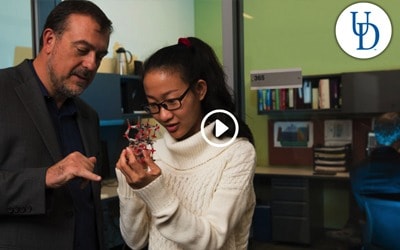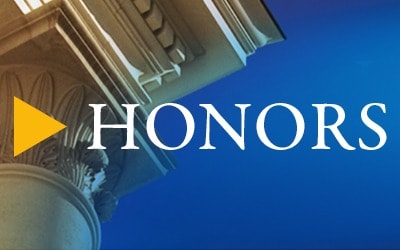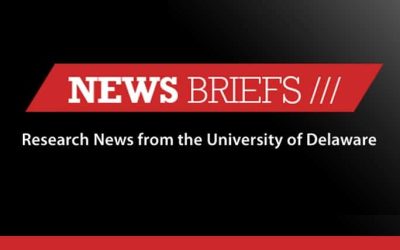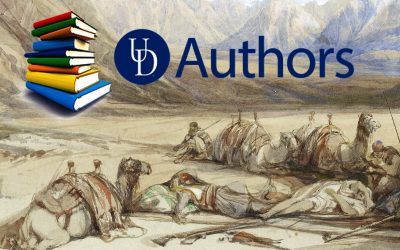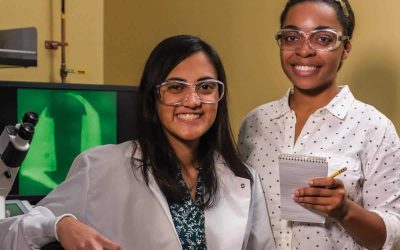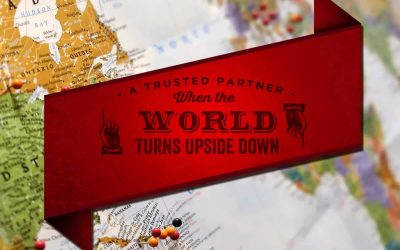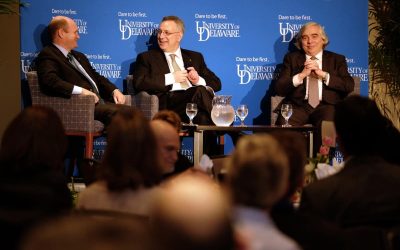Veteran journalist T. Joseph Scanlon, a respected journalism professor in Canada who became equally distinguished as a scholar in the sociology of disasters, had a longtime relationship with the University of Delaware’s Disaster Research Center.
The professor emeritus at Carleton University in Ottawa died in May 2015, but his UD connection will continue, with his papers now housed in DRC’s E.L. Quarantelli Resource Collection. The collection, a repository of some 70,000 items, is internationally known—like DRC itself—as a leading resource in the social and behavioral science aspect of disasters.
“Our collection is widely considered the premier collection of its focus in the world, and it’s heavily used by researchers,” said Pat Young, resource collection coordinator. “I get emails daily from around the world asking for information, and we typically have 10 to 20 visiting scholars a year making use of the collection.”
The T. Joseph Scanlon Collection, described as “vast and significant,” is being processed and preserved by Young, who will incorporate the papers, reports, data sets, photos, books and other materials into the resource center’s other holdings. Materials are not loaned outside DRC, but are made available to any visiting researchers or agencies.
Young called the Scanlon Collection “amazing.”
“I don’t think Joe’s importance to the field can be overstated,” she said. “And now, to be able to provide this wonderful resource to future researchers is incredibly important and the best way I can think of to honor his memory and his legacy.”
Prof. Scanlon typically visited DRC at least a few times a year and had close collaborations and friendships with its researchers, stretching back to the early days of the research center, which was founded in 1963 at Ohio State University and moved to UD in 1985.
Prof. Scanlon’s family is pleased that his papers will be part of DRC’s collection, said Meaghan Scanlon, one of his daughters.
“Dad always spoke highly of Delaware, and it seemed clear to our family that the DRC was the best place for his papers,” she said. “We’re very pleased to know that his archives are being cared for so well and haven’t doubted our decision to send the papers to Delaware for a single second.”
Whenever Prof. Scanlon visited the UD campus, Young said, he had two primary goals: to connect with DRC faculty members and students and to make use of the resource center for his own research.
He thought of himself as a kind of honorary Blue Hen, she said, usually making time to attend a UD basketball game or other sporting event while on campus and driving around Ottawa with a Blue Hen bumper sticker on his car.
He also contributed material to the resource center throughout his career.
Even before his family’s recent donation of his papers, the center housed more than 300 papers that Prof. Scanlon authored or co-authored. Young said his interests were wide-ranging, including the international response to disasters with mass casualties, and his scholarly work benefited from his expertise as a journalist.
“His interests were very broad, so we have a wide range of materials in his collection that we just would not have had access to any other way,” she said. “His background in journalism gave him a unique perspective, and it made him an amazing storyteller.”
MORE STORIES
Energy IQ
Put your Energy IQ to the test, and let’s see if you are an energy guru or a fossil fool.
Catalysis Center for Energy Innovation
Cool video highlights CCEI’s mission of turning cornstalks and wood chips into fuels, electricity and chemicals.
Honors
The UD community celebrates its first Gates Cambridge Scholar, two new fellows in the National Academy of Inventors, and the first woman to receive the Soil Science Society of America’s Kirkham Soil Physics Award.
News briefs
A humanoid robot joins the pediatric rehab team, a new UD study suggests online shopping may not be as “green” as we thought, a professor aims to improve student experiences in global health, and summer research all-stars take the field.
Keeping a killer flu in check
Who do you call when bird flu comes knocking? UD’s Avian Biosciences Center is working to contain the threat of bird flu—locally and globally.
Research Magazine Survey
We value your opinion. To show you how much, we will award a $100 Barnes & Noble gift card to three people who complete our survey. To be entered in this random drawing, please complete the survey by Nov. 1, 2016.
UD Authors
In her award-winning book, historian Christine Heyrman explores how the first U.S. missionaries in the Middle East influenced a nation’s attitudes toward Islam.
What science writing can teach us
Journalist, author and UD’s Distinguished Writer in Residence Mark Bowden shares lessons he learned as a science writer and recent samples of his students’ work.
New Train Station Project on Track for STAR Campus
An upgraded transportation hub in Newark will bring new riders and serve as an anchor for UD’s 272-acre Science, Technology and Advanced Research (STAR) Campus.
A trusted partner when the world turns upside down
Decisions made in times of disaster can be the difference between life and death, restoration and ruin. UD’s Disaster Research Center offers field-tested methods to strengthen recovery efforts.
Ch-Ch-Ch-Changes…
With significant change all around us, Delaware’s leaders—including the University of Delaware—are working to turn adversity into new opportunity.
Fueling the quest for green energy
Turning cornstalks and wood chips into renewable energy and valuable chemicals isn’t easy, but it is a promising focus of research at the Catalysis Center for Energy Innovation.





